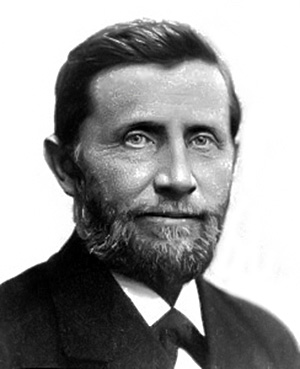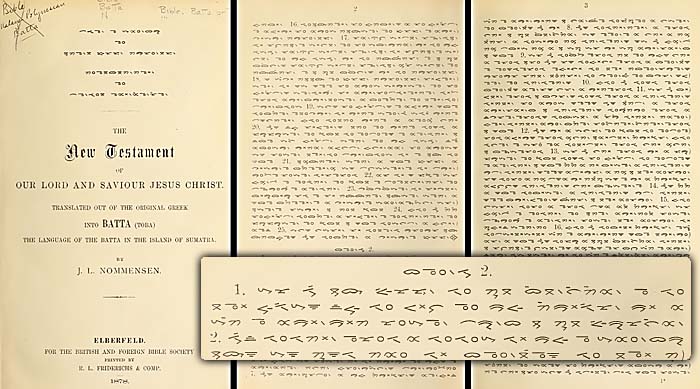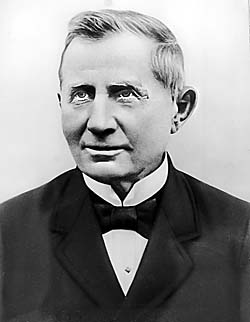An Apostle for the Batak
The protestant (Lutheran) missionary Ludwig Ingwer Nommensen is considered as one of the most successful christian missionaries in the history of missioning. He went to Sumatra in 1862 and spent 56 years there. Where all his predecessors failed, Nommensen managed to convert thousands of Batak People to christianity.

Ludwig Ingwer Nommensen (1834-1918). Date of the photo unknown. Image from wikipedia.org
Nommensen translated the New Testament, Martin Luther's small catechism, bible stories and a greater number of biblic stories and articles into the Batak language(s). Ludwig Ingwer Nommensen is nowadays still a highly revered personality among the christian Batak tribes around Lake Toba in north Sumatra. If one comes to these areas, one will find Nommensen still nowadays widely alive in the collective memory of the Batak People.
Nommensen was born in 1834 in Nordstrand, a small island in Denmark which became German in 1864 after the Prussian-Danish War. He was from a poor family. A key event in his boyhood was an accident with a horse couch. He got heavily injured and almost lost his legs. Nevertheless recovering his health, he decided to become a missionary. In 1857 he joined the Rhinish mission in Barmen (nowadays a part of Wuppertal).
Arriving in Sumatra in 1862, what was part of the then 'Dutch East Indies', he settled down in the high valley of Silindung. It took him years to convert the first Batak families. The Batak People have (still) a strong tribal identity and followed animist religions in this time (and partially still today). The first Westerners in the Batak countries were British and came here in 1824. Some of the predecessing missions had bad luck with the not allways friendly Batak population. Some missionaries got killed by locals, who celebrated a ritual cannibalism to scare foreigners away. In the years 1840/42 Franz Wilhelm Junghuhn mapped the southern Batak countries, but didn't reach Lake Toba further north. Junghuhn's excellent maps served also for the christian missionaries in the following years.

A sample of an 1878 edition of a Batak bible, translated by Ludwig Ingwer Nommensen from Greek into Batak language.
Imagecomposition by Asienreisender, 2014
When Nommensen came to Sumatra, the Dutch authorities didn't allow him to enter the Batak territories. There was considerable hostility in the local populations, particularly the opposition of the datu priests and the legendary Batak priest king Si Singamangaraja XII. They opposed the Dutch rule and foreign influences in general. Nevertheless, Nommensen was determined to start his work and went into Batak land despite the official Dutch prohibition.

Ludwig Ingwer Nommensen. Date unknown. Image from wikipedia.org
After overcoming countless obstacles in the first years he managed to convert some local chiefs and their families. It seems that he could cure some local people from their sufferings by applying modern western medicine and treatments and declared it a work of his christian god. Healing sicknesses is surely very helpful in making friends and explained religiously makes a missionary pretty convincing (faith healing). Probably he also was a creative master in the performance of very impressing hocus-pocus. Nommensen cared very much for a broad participation of the new Batak christians in their new church and, above all, respected and conserved the traditional Batak customs. Structure and organization of the church was adapted to the old, established Batak social order. Nommensen also advocated Batak interests against Dutch intentions, what led repeatedly to tensions with the Dutch authorities in Sumatra.
Certainly Nommensen was a gifted, energetic man with extraordinary rethoric skills. Besides he got support from other missionaries who followed, namely August Schreiber, P.H. Johannsen, A. Mohri and the Batak chief Pontas Lumbantobing, who became an early friend of Nommensen in Sumatra.
The first reported converts, 2,000 people in 1865, had to leave their villages and to go with Nommensen into his village, which he had named 'Huta Dame' (village of peace). In 1869 the first church was build, in 1882 the training of local vicars began. Hospitals (ambulances) were built, schools and a theological seminary followed.
Nommensen survived several assassination trials initiated by local animistic priests. In one case locals tried to poison him.
In a second missionary phase in the years 1881 - 1930 he converted a growing number of Batak People north of Lake Toba. In this time fell the Batak Wars (or 'Toba Wars'), in which the Batak People resisted over decades the Dutch colonial power under the leadership of charismatic Si Singamangaraja XII. Si Singamangaraja XII was allied with the sultan of Aceh, who led resistance against the colonial rule in the very north of Sumatra (the Aceh Wars). It seems that Nommensen's parish came under threat and he called the Dutch army for protection. In the first Toba War, a military expedition against Singamangaraja XII and his people, Nommensen supported the Dutch as an interpreter and cultural adviser. It was probably this involvement that the Dutch made him later a knight of the 'Dutch Order of Orange-Nassau'.

Traditional rice cultivation in form of small rice terraces with a sophisticated irrigation system in Batak Toba land. When Nommensen came to Sumatra, the Batak People had already an advanced social system with the democratic institution of the 'adat', a peoples assembly for decision making.
Image by Asienreisender, 2010
Last Years and Legacy
In 1904 the Rhinish mission wanted to pension off the missionary, but he refused to accept. He threatened the mission's headquarter in Barmen to continue the mission independently of them. The relationship to the Dutch colonial administration worsened very much and the Dutch tried to get rid of Nommensen in his late years. However, that wasn't possible in the time of the First World War. Nommensen didn't witness the end of the war. He died in May 1918.
Nommensen was married twice and lost both women. His first wife left him four children. In 1901 one of his sons was killed in Sumatra; another son died in the 'big war' of 1914-18.
When Nommensen died in 1918, the christian Batak church counted 180,000 members. In 1930 the Huria Kristen Batak Protesten (HKBP) church was founded in Balige, south of Lake Toba. They have now 2.5 million members and are the largest christian church in Southeast Asia and the largest protestant church in whole Asia. There is a Batak christian university in Medan, the biggest city in Sumatra with a branch in Pematang Siantar, named after Ludwig Ingwer Nommensen.
In the following years a number of successors continued the christianization efforts in the Batak lands. It was an explicit goal to contain outspreading islam, particularly from Aceh. Without the missionary work of Nommensen and others, the Batak People around Lake Toba were nowadays probably muslims.

A Batak Toba village on Samosir Island. These villages contain of a small number of houses of these kind, four to seven or eight in a row, facing a second row of similar houses. In the middle between them there is open space. The Batak Toba villages are hidden behind earthen walls who are overgrown with bushes and trees. These houses are still very traditionally built in the old Batak style, with the difference that the roofs are nowadays no more of reed grass, but made of tin. These roofs are easier to handle and sustain longer, but rainfall makes a hammering noise on them.
Image by Asienreisender, 2010